The best stretches for runners of the Beach to Bay Relay Marathon
May 19th, 2016 | 6 min. read
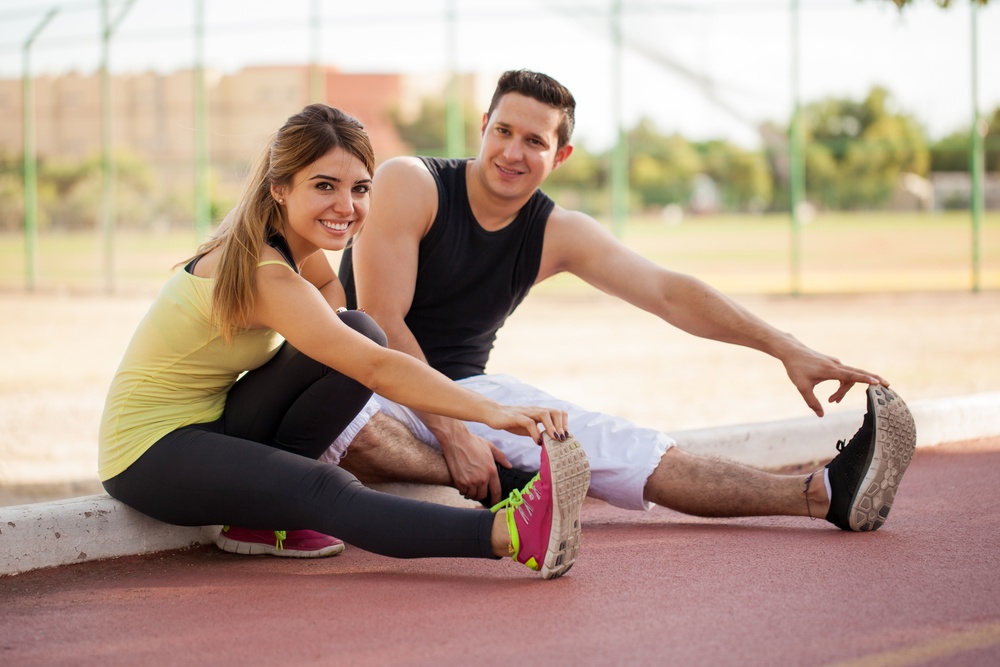
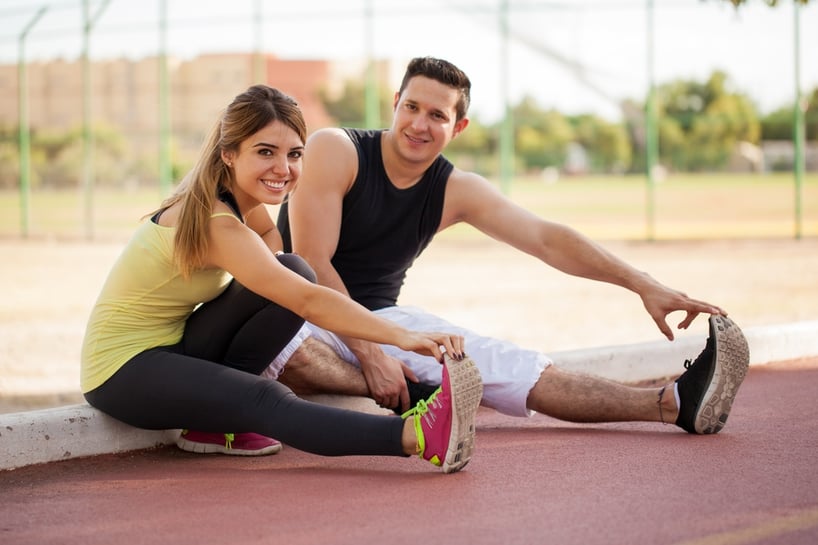
If you're preparing for the Beach to Bay Relay in Corpus Christi, you may be wondering, "What are the best stretching exercises for runners — particularly, marathon runners?" We at Coastal Ortho have compiled a list. But first: why stretch?
Benefits of stretching for runners
Many orthopedists recommend that runners incorporate a stretch routine into workouts — even when you're not preparing for a big race. Stretching your muscles on a regular basis (three times a week or even daily) has many benefits that can help protect your musculoskeletal system.
Routine stretching can:
- Improve your flexibility. Better flexibility through a full range of motion helps your joints and muscles to move more effectively. Efficient movement can boost your performance and may minimize your risk of injury.
- Increase blood flow to the muscles. Improved circulation and "warm" muscles may help minimize the risk of running injuries.
- Reduce muscle tension. Staying loose can help minimize post-workout soreness.
- Improve your posture. Better posture when running may improve your stride and efficiency.
Are you ready to design yourself a stretching program for Beach-to-Bay? Below is a list of proper stretches you can add to your training program.
RUNNERS' STRETCHES: Static stretches (routine/cool-down)
The following static stretches promote flexibility and should be a part of your regular stretching routine.
On the day of your race, warm up before performing these stretches, or save them for your cool down after the marathon.
Many runners prefer to use dynamic stretches before a race, to warm up muscles without over-relaxing them. (Some studies indicate that static stretches before a race may inhibit race performance.)
See below for a list of dynamic stretches.
A few basic stretching tips:
- Remember to warm your muscles up before stretching by walking or jogging lightly for ten minutes. (Some athletes may prefer to wait and stretch after they've completed their run and cooled down.)
- Hold each stretch for 10 to 30 seconds without bouncing. (Dynamic stretches are different; see below.)
- Breathe into the stretch.
- Always perform each stretch on both sides, to maintain symmetry.
- If you're stretching correctly, you should feel tension but not pain (unless you're sore from a previous workout).
- Before working out, limit your stretches to ones you can perform from a standing position. Floor stretches are best saved for your post-run stretching and cool-down routine.
- Aim to stretch at least three times per week.
Groin stretch
This exercise, sometimes called the butterfly stretch, works the inner thighs, hips, and groin. This is a seated exercise.
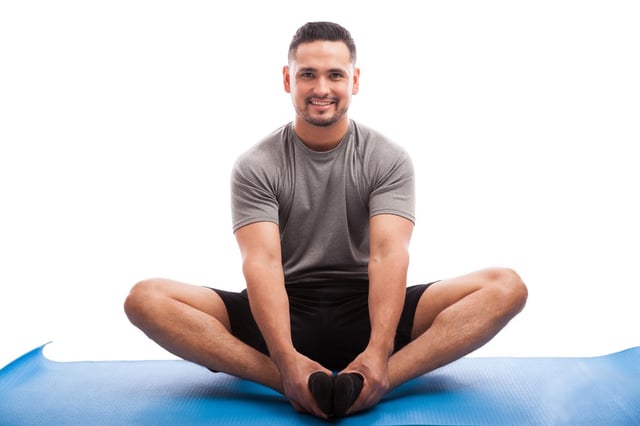
Sit down, bend your knees, and press the soles of your feet together in front of you. Hold onto your ankles, then slowly press your elbows into your inner thighs, pushing your knees towards the ground. To deepen the stretch, lean forward at the hip. Try not to hunch your back.
Hip stretch
The hip flexor lunge stretches out your hips. This is a standing exercise.
Keeping your feet pointed ahead, step your right leg forward. Keep your left leg straight behind you. Maintaining a flat back, slowly bend your front leg and push your buttocks forward until you feel a stretch across the front of your hip joint. Hold for 10 to 30 seconds, then switch sides and repeat.
Leg and knee stretches
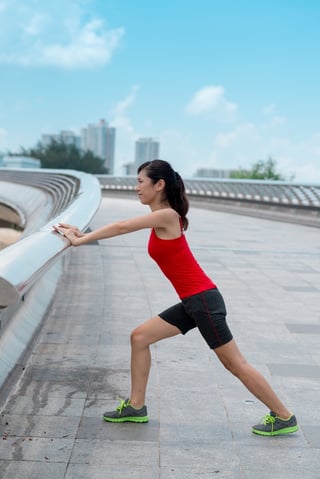
The following stretching exercises are good for stretching out the front and back of the leg. Done regularly, they help to loosen muscles that get tight from sitting all day at a desk.
Performing these stretches regularly may help to minimize the risk of running-related pain like runner's knee (patellofemoral pain syndrome).
Buttock stretch
This exercise is floor-based.
Lie on your back with your knees bent, keeping both feet flat on the floor. Cross your right leg over your left thigh (your ankle will be resting against your thigh).
With both hands, gently pull the back of your left thigh toward your chest, until you feel a stretch in your right buttock. Hold for 10 to 30 seconds, then switch sides and repeat.
Calf (back of lower leg) stretch
This exercise is a standing stretch.
Lean against a wall or other solid support, like a chair, fence, or even your car. Stand with one leg forward and one leg back. Bend your front leg, keeping your back leg straight.
Slowly shift your hips forward, maintaining a flat lower back. Move forward until you feel a stretch in the back of your back leg's calf (do not bounce!). Hold for 10 to 30 seconds, then switch legs.
Hamstring (back of thigh) stretches
- Stretch #1: Seated hamstring stretch. The easiest way to stretch your hamstrings is with this floor-based exercise.
Sit down and straighten your right leg. Bend your left leg with the sole of your foot resting next to the inner thigh of your right, extended leg. Lean forward from your hips and reach toward your right foot. Hold for 10 to 30 seconds, then switch legs and repeat.
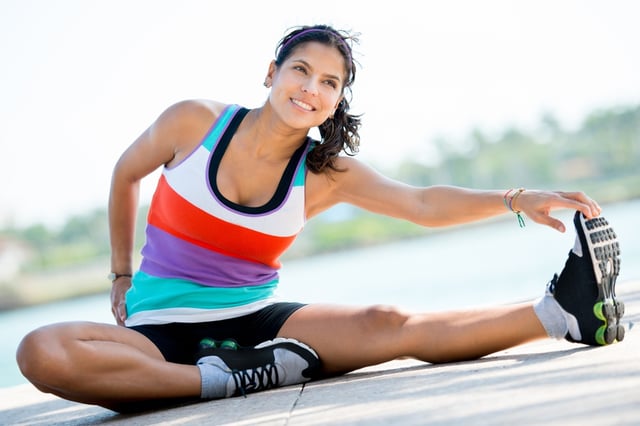
- Stretch #2: Standing hamstring stretch. This is a standing variation on the classic hamstring stretch, above.
Stand with one leg in front of the other. Keep your hands on your hips. Straighten your front leg, toes pointing up. Bend your rear leg. Lean forward at the hips with a flat back, until you feel a stretch in the hamstring of your straight leg. Hold, then switch sides and repeat.
Iliotibial band (IT band, outside of leg) stretch
The IT band runs down the outside of your leg, from the hip to the ankle. A tight IT band is a common source of soreness and injury in long-distance runners.
To stretch your IT band, cross your left leg in front of your right. Maintaining a flat back, lean to your left side and push your right hip out. (Don’t bend forward!) If you're performing the stretch correctly, you'll feel a stretch along your outer right thigh and hip. Hold this position for 15 seconds, then switch sides and repeat.
Quadricep (front of thigh) stretch
Leaning against something stable for balance, reach behind you with your left arm and hold the top of your right foot. Gently pull your heel towards your buttocks. Hold for 10 to 30 seconds, then repeat with the other leg.
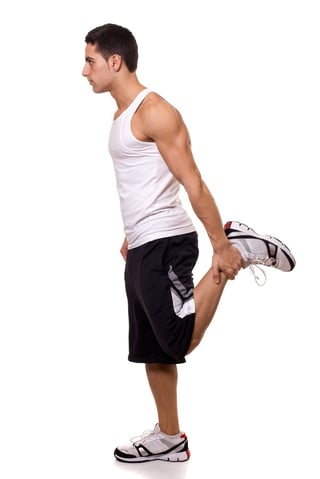
Lower back stretches
Lower back exercises are floor-based. Perform these on a flat surface; use a mat if you can.
Stretch #1: Squeeze
Lie down. Tighten your hip muscles and abdominals at the same time, flattening your lower back. Hold for five to eight seconds. Relax. Repeat two to three times.
Stretch #2: Knee-to-Chest
Keeping your back flat, pull one leg toward your chest. (Keep your head on the floor.) Hold your knee to your chest for 15 seconds. Relax. Repeat on the other side.
runners' stretches: dynamic stretches (routine/warm-up)
These basic running stretches are some of the best dynamic stretches for runners.
To minimize your risk of injury on race day (or any day that you're hitting the pavement or track), consider making some of the following dynamic stretches part of your regular stretch routine.
Dynamic stretching exercises
Dynamic stretches are stretches that move your joints and muscles through a full range of motion. These increase the blood flow to your muscles, warming your body up before a race.
Some common dynamic stretches that marathon runners use during race warm-up include:
- Arm circles or cross body arm swings. These loosen up the arms and shoulders.
- Neck rolls, rolling your head slowly from side to side. These reduce tension in the neck and shoulders.
- Front kicks. Walk forward, lifting your legs straight out. Take 20 steps like this.
-
Butt kicks. Walk forward, kicking your heels in towards your glutes. Do 10 kicks per leg.
- Hip circles. Stand with your hands on your hips with your feet hip width apart. Slowly rotate your hips clockwise, then counterclockwise. Repeat this 10 times.
-
Leg swings. Hold onto something stable (a fence, a car, or another runner). Swing one leg to the side, then swing it back across your torso. Repeat this movement 10 times for each leg.
- Walking lunges. Step forward with your hands on your hips and your back straight. Bend your front knee and drop your back knee near to the ground. Keep your front knee over your ankle. Stand and switch legs. Try to use a long, fluid stride. Repeat 10 times for each leg.
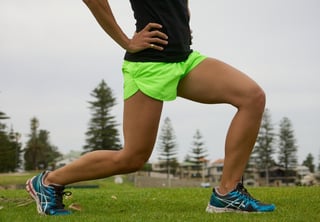
RUNNERS' STRETCHES: COOL-DOWN
Immediately after your race, walk slowly for about five to ten minutes to cool down and return your heartbeat to normal. Then, find a quiet spot to perform the routine static stretches listed above.
These stretches relax your muscles after the race and help to keep you flexible through a full range of motion.
stretches for runners: common questions
Should I stretch before running or after?
Some studies indicate that static stretching immediately before a run may hurt your performance. Dynamic stretches, however, can warm up your muscles without over-loosening them.
You should stretch after any exercise, however, to keep loose and prevent your muscles from tightening up.
Whether or not you stretch before running is an individual choice. Experiment. Always make sure you're warmed up first.
What are the best stretches for beginning runners?
All of the static stretches and dynamic stretches listed above are suitable for beginners. Remember to go slow and don't overstretch to the point where you feel pain.
Does stretching make me faster?
Dynamic stretching before a race is thought to improve performance in runners. However, there are no guarantees. The most important part of any race is to enjoy yourself with a minimum of pain.

Will stretching help prevent orthopedic injuries?
Studies indicate that stretching may not necessarily prevent injury. Some runners get injured regardless of whether or not they stretch.
However, regular, routine stretching does improve your overall flexibility, which is why orthopedists often recommend it as part of your regular fitness routine.
Flexibility in your legs, hips, knees, and spine can affect the mechanics of your walking gait and running stride, which can eventually affect your long-term likelihood of other injuries or conditions like:
If you're a marathon runner or long-distance runner with an injury or pain you think may need attention, give Coastal Orthopedics, located in Corpus Christi, TX, a call. Our orthopedic specialists can assess your condition and help you determine what treatment option is best for you. Telephone: 361.994.1166.
Article written by: Rob Williams, MD
Dr. Williams has been practicing orthopedic surgery in Corpus Christi since 1998. After graduating from Texas Tech hereceived his medical degree from the University of Texas at San Antonio. At the prestigious Campbell Clinic located at the University of Tennessee, Dr. Williams completed not only an Orthopedic Surgery Residency, but an additional year of Fellowship Training in Spine Surgery. Dr. Williams is dedicated to creating an excellent patient experience in the office or in the surgery suite.
Topics:

